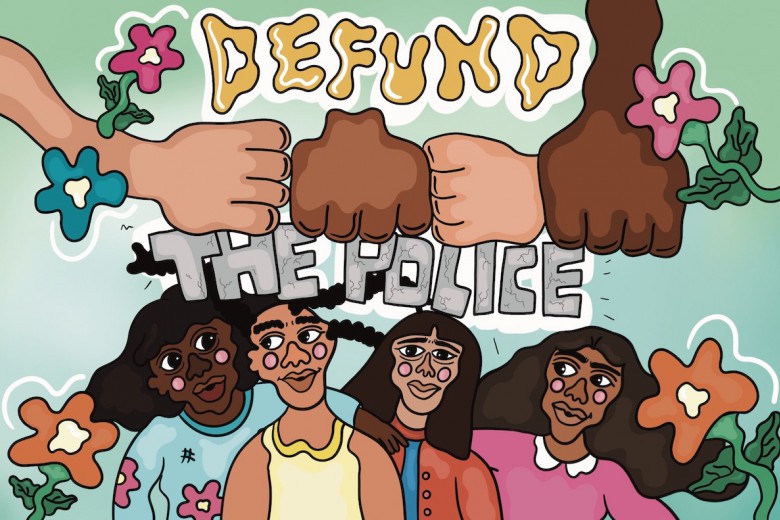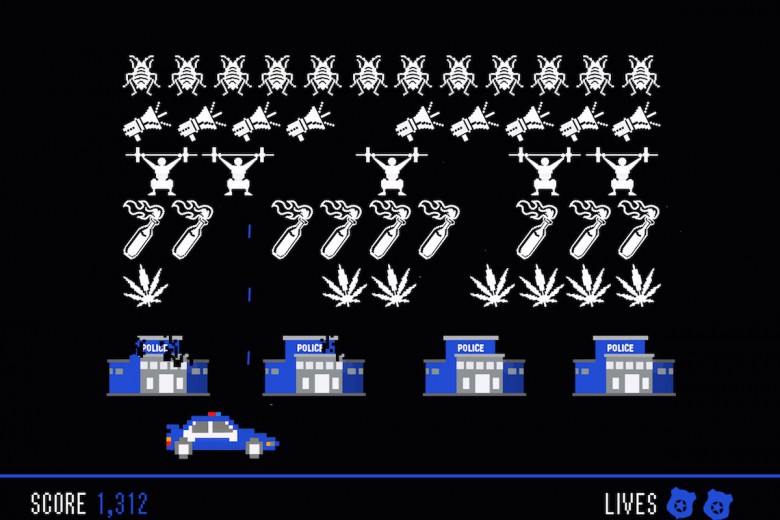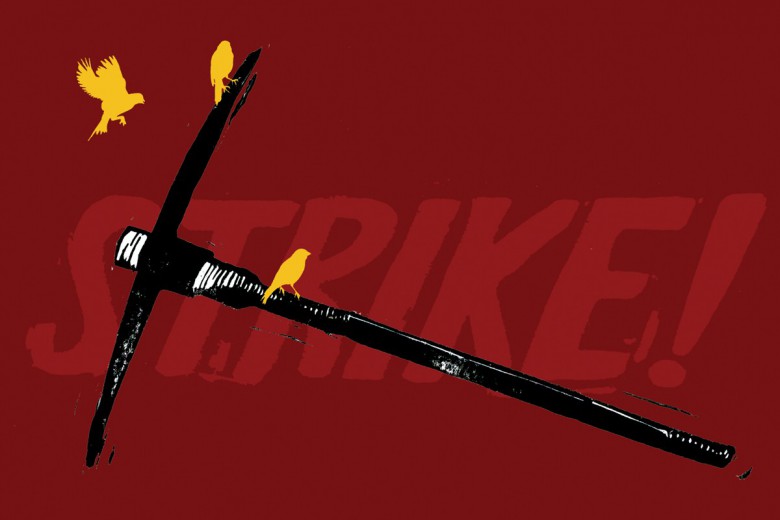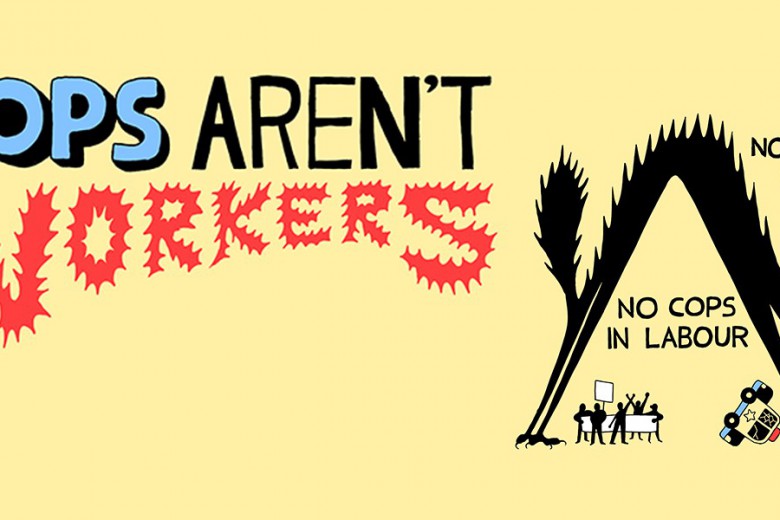A window shatters. Ominous music blares. A white teenager takes shelter in a closet as they frantically dial 911.
But nobody picks up. The 911 operator’s desk is unoccupied. A hold message tells the teen not to hang up and that “an operator will be with you shortly.” It’s too late. A shadow descends over the panicked teen as they lower the phone from their face.
“Why is Winnipeg 911 not fully staffed?” a voice intones. “Ask Mayor Bowman. When you dial 911, Every. Second. Counts.”
The 30-second attack ad – which aired on local television stations in the lead-up to the 2018 Winnipeg municipal election – was produced by the Winnipeg Police Association (WPA), the union that represents more than 1,400 police officers and 450 civilian support staff in the Winnipeg Police Service (WPS).
Despite the police force receiving increases to its budget in previous years, WPA president Maurice Sabourin claimed the graphic ad was necessary due to “inadequate police budgets” and to “bring attention to the problem with public safety in Winnipeg.” Sabourin explicitly called for funding cuts to public transit and active transportation in order to increase the police budget.
But the intended message was clear: give more funding to the police or Winnipeggers will die.
The attack ad was swiftly condemned by Mayor Brian Bowman, who called it “fear-mongering,” while WPS Chief Danny Smyth said that police couldn’t find any specific example in the 911 logs of the situation depicted in the video.
But the intended message was clear: give more funding to the police or Winnipeggers will die.
The actual history of the WPA itself tells a very different story. Over the last several decades, the police union has offered unrelenting defence to cops who themselves kill, assault, and harm people. The victims of this violence are often Indigenous. It’s through the suppression of these stories that police unions continue to control definitions of public safety.
“Police unions are a kind of dangerous political animal because they are only concerned about themselves and they have this kind of parasitic solidarity that isn’t actually a solidarity that extends to other workers,” says Kevin Walby, associate professor of criminal justice at the University of Winnipeg, in an interview with Briarpatch. “They’re only interested in consuming the public purse as much as they can. It manifests itself in all these kinds of aggressive ways.”
The paradox of police unions
Unfortunately, the WPA serves as an especially strong example of this “parasitic solidarity.”
The city’s police department now receives 26.6 per cent of the municipal operating budget – up from only 16.9 per cent of the budget in 2000 – which is the highest proportion of any major city in Canada. A full 85 per cent of the WPS’s $304.1 million budget goes toward salaries and benefits, with almost 1,300 police officers earning over $100,000 in 2019.
And the WPS is exceptionally brutal, killing three Indigenous people in the span of 10 days in April, including 16-year-old Eishia Hudson. Some of the department’s most egregious actions have received U.S. coverage by the Wall Street Journal and NBC News.
It’s critical for us to familiarize ourselves with the material practices of police unions in order to effectively resist their propaganda and power.
As York University’s Mark P. Thomas and Steven Tufts observed in a recent journal article, police unions are paradoxically workers’ organizations that play a central role in maintaining capitalist repression of other workers. They write that police unions “undermine and criminalise movements that contest police violence against racialised communities and … more broadly counter working class resistance to austerity and right-wing authoritarian populism.”
“They’re only interested in consuming the public purse as much as they can. It manifests itself in all these kinds of aggressive ways.”
Police unions have won significant increases to salaries, benefits, and pensions over the years, taking away resources from life-sustaining services like libraries, transit, fire and paramedic services, parks, and public works.
“Paid duty,” in which off-duty police are contracted by sports venues and private stores for security, is another way they increase their already substantial income: “Those are incredibly lucrative for individual officers; sometimes they double their salaries,” says Walby, who has published extensively about this “private employment of public police.”
David Camfield, labour studies associate professor at the University of Manitoba, explains that police officers’ high pay won through binding arbitration is a way for the ruling class to maintain what Lenin called “special bodies of armed men” distinct from the general population and unlikely to show solidarity with the working class like they did during the 1919 Winnipeg General Strike.
“Over time, the process has been to raise the pay of cops higher in relation to average working-class income as part of that,” Camfield says in an interview with Briarpatch.
Police unions wield enormous political clout. They’re also concerningly involved in various charity efforts; for example, the WPA runs an “anti-bullying initiative” for K–8 students called Cool 2Be Kind – former NDP MLA Kevin Chief was a co-chair of the campaign in 2019 – which presents an obvious obstacle to ongoing efforts to get police influence out of schools.
Police officers’ high pay won through binding arbitration is a way for the ruling class to maintain what Lenin called “special bodies of armed men”
This article focuses specifically on the role of the police union in defending killer and abusive officers, including the “code of silence” practised by police in protecting fellow officers from allegations of serious harm. These threatening tactics are inevitably used in other arenas, too – like what CBC called the “withering glare of [a] phalanx of off-duty officers” who showed up to protest Winnipeg city council’s changes to their extremely lucrative pensions.
Contrary to the claims made in the 2018 attack ad, police don’t keep people safe. Rather, the inherently violent nature of policing causes an array of atrocious harms, particularly against people who are Indigenous and Black, poor and unhoused, drug users, sex workers, queer, trans, gender non-conforming, and/or have disabilities and mental health issues.
Police unions are at the very centre of defending this violence.
The killing of J.J. Harper
It’s not unusual for a union to defend its members against criticism and potential termination: that is, after all, one of the biggest appeals of organized labour.
The modern history of the WPA goes well beyond that, however, with the organization engaging in near-ceaseless obstruction of accountability for members who kill and assault people.
At least two former WPA presidents have been implicated in serious harms themselves: in 1990, James Hanson was arrested and charged for sexual assault against teenage boys, uttering threats, and possession of a weapon, while John Campbell was arrested and charged with impaired driving and refusing a breathalyzer test.
As reported by the Montreal Gazette at the time, “Campbell was a central figure in the police union’s struggle to prevent Manitoba’s native-justice inquiry from investigating the shooting of Indian leader J.J. Harper.”
The WPA’s actions during that now-famous Aboriginal Justice Inquiry (AJI) are a quintessential example of how police unions operate to obstruct and undermine justice.
“Campbell was a central figure in the police union’s struggle to prevent Manitoba’s native-justice inquiry from investigating the shooting of Indian leader J.J. Harper.”
The AJI was called in April 1988 in response to two events. First, 16 years after the horrific murder of 19-year-old Cree woman Helen Betty Osborne, one of the four men involved was finally sentenced in 1987. Three months after that trial, J.J. Harper, a member of the Wasagamack First Nation and executive director of the Island Lake Tribal Council, was killed by Winnipeg officer Robert Cross.
The WPA deployed a series of increasingly absurd obstructions to try derail the inquiry, including filing a court motion to exempt the shooting of Harper from the inquiry, claiming the inquiry was invalid because the order-in-council establishing it wasn’t published in French and therefore contravened the Manitoba Act, and applying for an injunction to prevent officers from turning over their notebooks containing evidence about the killing of Harper.
After several delays caused by the WPA’s actions, the inquiry’s review of the Harper killing finally started in August 1989. The WPA immediately deployed a new strategy of appealing to the killer cop’s allegedly fragile mental state, with its lawyer arguing that “there has been a great deal of suffering on the part of Const. Robert Cross” and calling for his exemption from testifying.
The night before Cross was scheduled to testify, he was admitted to a psychiatric unit in what Campbell called “an extremely emotional and possibly suicidal state.” The lawyer for the Island Lake Tribal Council responded to the news by stating: “Credibility is lost by virtue of all the attempts to thwart him testifying in the past. You can only cry wolf so many times.”
The union’s lawyer added that police “are mistreated by society because they are society’s whipping boys.”
Cross was eventually ordered to testify by the inquiry’s judges, who recommended that he retain new independent counsel as the WPA “may have only worsened his pain” by trying to obstruct the hearings and testimony. Despite the WPA’s claims to Cross’ mental state, media reported that observers were “surprised by his composure on the witness stand.”
In its final arguments to the inquiry, the WPA’s lawyer argued that Harper would still be alive if he had answered the police officer’s questions, and that Cross was simply “a policeman doing his duty.” The union’s lawyer added that police “are mistreated by society because they are society’s whipping boys.”
The AJI report was released in 1991. The Montreal Gazette reported that the police union “reacted with silence and scorn” to its critical findings, saying that it wanted Cross to eventually return to active duty.
Another proposed investigation into the killing, this time conducted by the Law Enforcement Review Agency (LERA), was slammed by WPA lawyers as “cruel and unusual” treatment of Cross. The police union argued that the complaint to LERA wasn’t valid as it was filed by Harper’s half-brother, Harry Wood, who wasn’t present at the shooting, and following up on the matter could lead to the agency becoming “overwhelmed by a plethora of complaints.”
While the investigation ended up proceeding and determining that Cross had used excessive force, Cross maintained he did nothing wrong.
A history of violence
The Harper inquiry was far from the only time the police union has sought to undermine and obstruct accountability processes.
In 1989, a year after Harper was killed, the WPA announced that it was going to start suing people who filed “malicious complaints” against police officers to LERA, to prove the “police watchdog agency is useless and should be abolished.” Police union president John Campbell campaigned for the position pledging to eliminate LERA, telling media: “It’s not fair that police are the only profession singled out.”
A decade later, in 1998, more than 100 police officers conducted a sickout to protest the suspension of Grant Eakin, who was charged for assaulting a handcuffed man during an arrest for a complaint about a loud stereo. The WPA fought the suspension, claiming in 1999 that the department had “bowed to public pressure” by suspending Eakin and violated labour laws by considering newspaper reports of past allegations against him in its decision.
In the early 2000s, the WPA again sought to undermine an inquest examining allegations of racism against police for ignoring five 911 calls over eight hours from Métis sisters Doreen Leclair and Corrine McKeown, who were murdered by the latter’s ex-boyfriend, William Dunlop, in the city’s North End. Emergency operators had accused the sisters of lying, asked if they had been drinking, and sent police officers to lunch instead of responding to the complaints.
The WPA claimed the poor response time was the result of “insufficient resources,” with the union’s lawyer arguing, “if there is a few that weren’t handled the way they should, that’s still a hell of a percentage that were handled properly.”
In 2009, when it was found that three officers had been accused of fabricating evidence in criminal cases, WPA president Mike Sutherland said, “in terms of allegations, there is a relatively small number at any time.”
The police union also made a failed attempt to require the killer to testify at the inquest. David Chartrand, president of the Manitoba Métis Federation, responded to the WPA’s request as “a way to find the victims to blame” and “irrational, distasteful and totally wrong.”
In 2005, the WPA defended the practice of 50 off-duty officers cramming into a courtroom to watch a police brutality hearing – which one of the complainants responded to by saying, “I feel all the officers here are intimidating me” – by stating it was a “public process” and “members are here on their own time.”
In 2006, WPA president Loren Schinkel said officers would support the installation of cameras in patrol cars “as long as they were promoted for officer safety and not officer accountability.”
In 2008, the WPA downplayed criticism of the police killing of 26-year-old Craig McDougall, a distant relative of J.J. Harper, by suggesting: “There are a lot of Monday-morning quarterbacks out there that are willing to look in hindsight and find fault.”
In 2009, when it was found that three officers had been accused of fabricating evidence in criminal cases – including in the 2007 shooting of an 18-year-old falsely accused of a robbery, for which one officer was charged with attempted murder – WPA president Mike Sutherland said, “in terms of allegations, there is a relatively small number at any time.”
Protesting “the chill of litigation”
In mid-2009, Winnipeg officer Ryan Law – the nephew of then-police chief Keith McCaskill – was charged with aggravated assault for beating 45-year-old Henry Lavallee in a Winnipeg Remand holding cell, resulting in a ruptured colon and near death due to internal bleeding.
WPA president at the time Mike Sutherland responded to the charge by stating that he didn’t want officers to feel afraid to use force: “I’m just concerned we’re entering an era where officers are going to experience the chill of litigation. … Once you start putting handcuffs on police officers, you pretty much let criminals have free rein.”
Two weeks after that, Lavallee spoke about his experience for the first time at a news conference hosted at the Southern Chiefs’ Organization offices. In response, Sutherland challenged the motivations for the news conference: “Is it an attempt to sway public opinion by presenting an unchallenged viewpoint? I’m not sure. But it certainly gives rise to questions.”
“I’m just concerned we’re entering an era where officers are going to experience the chill of litigation. … Once you start putting handcuffs on police officers, you pretty much let criminals have free rein.”
Law, who beat Lavallee nearly to death, was involved in another incident in 2009, while on administrative leave, in which he and other officers repeatedly struck a man who was on the ground while being arrested and didn’t show any “overt resistance,” according to the judge. Sutherland said he was “pleased” that the officers wouldn’t be charged.
In 2010, the WPA responded to news that the family of 17-year-old Michael Langan, who died after being tasered by Winnipeg police, were planning to sue by stating it supported the continued use of the weapon: “Until a better option comes along, candidly, it’s a tool that I think for the most part actually reduces injuries,” Sutherland said.
The next year, the WPA requested that city council allow the disciplinary records of police officers to be expunged after five years, preventing them from being used in future disciplinary proceedings and court cases. Sutherland of the WPA defended this request by arguing, “I think there should be an opportunity for people to put mistakes in the past.”
An article in the Winnipeg Free Press argued that the request “serves the interests of police officers alone” and “as an issue of justice, it seems grossly inappropriate.”
Drinking and killing
Many police officers have been defended by the WPA for actions specifically involving drinking and driving, including a former president of the police union.
In 1999, the WPA called for the immediate reinstatement of Winnipeg officer Bob Lesuk, who had been convicted of dangerous driving and refusing a breathalyzer in a 1997 motorcycle crash that killed 26-year-old Koreen Wood. Lesuk was fined $500 and had his licence suspended for three months.
In 2007, Winnipeg officer Daniel Aminot crashed his motorbike into a median after driving the wrong way into oncoming traffic. A breathalyzer test wasn’t administered until three hours after the crash – and even then it reported a blood alcohol level of .20, almost three times the legal limit.
Aminot was let off in 2009 with a $1,500 fine and one-year licence suspension, and he continued to work as an officer. Sutherland celebrated Aminot’s employment, telling media, “Police are not perfect. Police are going to make mistakes. It’s going to happen from time to time, but we do the best we can. But we are human and with humanity comes those types of frailties.” Concerning the one-year licence suspension, Sutherland remarked: “There’s lots of roles in the police service you can fulfil without having to drive.”
“Cops say ‘don’t drink and drive,’ but this makes me feel like they can do whatever they want.”
In 2005, Crystal Taman – a 40-year-old mother of three – was hit and killed by intoxicated Winnipeg officer Derek Harvey-Zenk, who refused a breathalyzer test. A defence lawyer told media that WPA lawyers had frequently explained to officers how breathalyzer evidence would be used against them, implying they should avoid consenting to a test if drunk.
In August 2008, Taman’s family walked out of an inquiry hearing when a WPA lawyer denied that officers who had been drinking with Harvey-Zenk the night of the crash had withheld evidence. A Free Press columnist argued, “If these cops have been painted as Thin Blue conspirators, it is by their own hand.”
In 2016, veteran Winnipeg officer Trent Milan – who was facing 34 criminal offences, including theft, possession of dangerous weapons, and many drug-related charges – died in a 2016 crash with a gravel hauler. The WPA responded to the crash by emphasizing that the officer had never been found guilty in court for his alleged crimes: “At the end of the day, this is a tragedy that has happened. And everybody has jumped to conclusions,” said WPA vice-president George Van Mackelbergh.
Most recently, in 2017, Winnipeg officer Justin Holz killed 23-year-old Cody Severight in a drunken hit and run. Once again, he wasn’t tested with a breathalyzer until hours after the crash. The victim’s aunt told media that the family had lost all trust in police: “Cops say ‘don’t drink and drive,’ but this makes me feel like they can do whatever they want.”
The WPA celebrated the eventual clearing of two other officers suspected of “irregular conduct” relating to the investigation, claiming that police morale was “in the basement” and suspicion toward officers “takes the wind out of their sails.”
Claiming “reverse discrimination”
This appeal to victimhood has only escalated in recent years.
Thomas and Tufts of York University write in their journal article that the police discourse of “reverse discrimination” inverts Black Lives Matter and “constructs an equivalency between these movements, thereby undermining critiques of racialised violence committed by the police.”
For example, in 2016, the WPA responded to the charging of Toronto police officer James Forcillo for the killing of 18-year-old Sammy Yatim by suggesting that “increased scrutiny of police shootings has already caused many officers to second-guess themselves in volatile situations” and that officers have been injured because they hesitated.
Sabourin has also complained about officers constantly being filmed as proof that “we’re one of the most scrutinized professions on the planet” (there have also been multiple instances of Winnipeg officers taking the cameras of people filming them, as well as intimidating and threatening witnesses who film police activities).
In 2018, the union celebrated the acquittal of Winnipeg officer Remi Van Den Driessche – accused of sexual assault, extortion, and harassment of women he stopped on the street – by again invoking a victim narrative: “If it had been a regular citizen, this likely would have been stayed a long time ago, based on the evidence,” Sabourin said.
In 2020, the police union stepped up to defend Winnipeg officer Jeffrey Norman – who has been sued at least eight times since 2005 for accusations that include excessive force and wrongful arrest – after it was alleged that he had beaten an Indigenous teenager whom he suspected of theft unconscious with a baton while off duty. In 2019, Norman allegedly pepper sprayed and detained a cyclist who had asked him to turn off his high beams in a residential area.
Sabourin appealed to Norman’s constitutional rights to privacy as a reason for Sabourin not to speak to media about his conduct: “In general, our members, like all Canadian citizens, have rights to privacy where appropriate.”
Abolish the police (union)
Throughout the last several decades, the WPA has consistently shielded its members from scrutiny over some of the most heinous violence imaginable.
It has actively impeded investigations into police killings like the Harper inquiry and deaths caused by police negligence, like the murders of Leclair and McKeown. The police union has worked exceptionally hard to protect members who drink and drive, even when they kill people like Crystal Taman and Cody Severight. There appears to be no level of harm inflicted that is too egregious for the WPA to defend.
The WPA is only one example of many police unions across the country, including the national Canadian Police Association, the Toronto Police Association, the Fraternité des policiers et policières de Montréal, and the Vancouver Police Union, all of which have their own histories of obstructing accountability and expanding police power – which in turn undermines funding and prioritization of anti-carceral alternatives for genuine public safety.
Like policing in general, there is no way for police unions to be reformed. They must be marginalized, fought against, and abolished.







